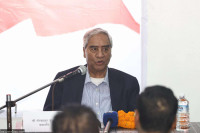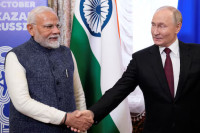Opinion
Geopolitical rivalry in SAsia
As the gap between India and China continues to widen due to several bilateral and international issues, both countries are competing to increase their influence in Saarc countries. India is struggling to retain its influence in these countries, while China is keen to increase its clout.
Kamal Dev Bhattarai
As the gap between India and China continues to widen due to several bilateral and international issues, both countries are competing to increase their influence in Saarc countries. India is struggling to retain its influence in these countries, while China is keen to increase its clout.
On April 7, Bangladeshi Prime Minister Sheikh Hasina visited India after a hiatus of seven years. Both countries signed more than three dozen agreements, including three pacts on defence cooperation. This is the first time that the two countries have signed a deal on the purchase of military hardware by Bangladesh from India. The deal has been signed amid reports that military ties between China and Bangladesh are growing. Recently, China supplied two submarines to Bangladesh.
Breaking with protocol, Indian Prime Minister Narendra Modi received Sheikh Hasina at the airport. India announced a $5billion credit line to Bangladesh, which is the largest amount offered to a country in India’s immediate neighbourhood. However, Hasina faced internal criticism for failing to sign a deal on the sharing of water of the Teesta River and for signing defence agreements.
Protests from West Bengal Chief Minister Mamata Banerjee indicate that a water-sharing deal is unlikely in the near future, but it seems that India is ready to take all possible measures to continue its influence in Bangladesh. As Bangladesh is holding parliamentary elections in 2018, Hasina was angling towards signing a water-sharing deal with India, thus making it a favourable election agenda to garner votes.
Hasina’s failure to sign the deal could be turned into an election agenda for opposition parties. The media and civil society as well as opposition parties in Bangladesh are all voicing their opinion in favour of signing the water-sharing deal. However, they also maintain that Modi’s positivity about Teesta is not enough.
Despite Indian efforts, China has been increasing its influence in Bangladesh. China is the biggest trading partner of Bangladesh. In October 2016, Chinese President Xi Jinping visited Bangladesh; this was the first visit to Bangladesh by a Chinese head of government in 28 years. The sole purpose of the visit was to counter New Delhi’s influence. During the visit, the two countries signed 27 agreements. China pledged $24.45million for development purposes in Bangladesh. Prior to this, Indian Prime Minister Narendra Modi had visited Dhaka in 2015 and signed 22 agreements.
Changing regional dynamics
China’s presence has been growing in the Maldives as well. This is proving worrisome for India. China is involved in major infrastructural development in Maldives. The construction of Hambantota port, Norochcholai thermal plant, and several roads, railways and other port city projects are some of the examples. The growing military, political and diplomatic engagement between China and Pakistan is also obvious. Pakistan’s ties with India are souring, causing it to draw closer to China. The China-Pakistan Economic Corridor is the latest example of growing ties between the two countries.
India and China are competing to increase their influence in Afghanistan as well. Both countries are enhancing bilateral security cooperation. India delivered helicopters to Afghanistan in December 2015; there is increasing defence cooperation between the two countries. India also constructed a parliament building in 2016 as a gesture of bilateral goodwill. In 2016, India organised a Heart of Asia Conference in New Delhi to discuss development and stability in Afghanistan.
Meanwhile, China is also increasing its security role in Afghanistan. There are media reports that Afghanistan and China have started joint military patrolling. China has also shown interest in facilitating talks with the Taliban. Chinese Assistant Foreign Minister Kong Xuanyou visited Afghanistan in November 2016 to discuss the development of train lines between the two countries. Reports suggest that China continues to engage with Afghanistan through bilateral and multilateral forums.
Compared to other Saarc countries, India continues to maintain its influence in Bhutan. But there are reports that China is trying to expand its influence in Bhutan as well.
The case of Nepal
India seems apprehensive about the growing Chinese influence in Nepal—especially in defence and security issues. During informal talks, Indian officials indicate that they are willing to provide support to the Nepal Army, and show their displeasure over increasing Chinese influence. This is a concern that is expressed by the Indian media and policy makers as well. Indian leaders and officials believe that Chinese influence in Nepal increased considerably after the blockade, particularly due to the leanings towards China of the erstwhile KP Oli-led government. The Oli-led government signed a trade and transit pact with China; however, implementation of those agreements has been tardy. Prime Minister Pushpa Kamal Dahal’s visit to China did not produce any concrete outcomes concerning the implementation of past agreements.
Nepal and India are also increasing the frequency of high-level visits. In September, Prime Minister Pushpa Kamal Dahal paid a state visit to India. He visited India once again in October, with the purpose of participating in the BRICS-BIMSTEC outreach summit and holding talks with Indian political leadership. Indian President Pranab Mukherjee was the first head-of-state to visit Nepal in 19 years. President Bidya Devi Bhandari is currently on a state visit to India. Minister-level visits by Indian officials to Kathmandu are also increasing. Indian Finance Minister Arun Jaitly and Railway Minister Suresh Prabhu visited Nepal recently. Indian leaders and think-tanks are increasingly assertive about holding discussions on bilateral issues.
The Bangladeshi prime minister is facing charges of being pro-Indian from her domestic constituencies. Opposition parties are criticising her for tilting towards India; this will be a major political agenda in the 2018 parliamentary elections. In Nepal, Prime Minister Pushpa Kamal Dahal is also facing charges of leaning towards India. The main opposition CPN-UML has made this a major political agenda. It seems Saarc countries are failing to devise a foreign policy to maintain a balanced relationship with the two Asian giants, India and China. Such a foreign policy would enable them to reap maximum economic and development benefits. Instead of being on the same page about formulating a stable foreign policy, major political parties in these countries are divided when it comes to dealing with India and China. The cases of Nepal and Bangladesh are similar in that respect.
Bhattarai is Delhi correspondent of The Kathmandu Post




 9.12°C Kathmandu
9.12°C Kathmandu








%20(1).jpg&w=300&height=200)

